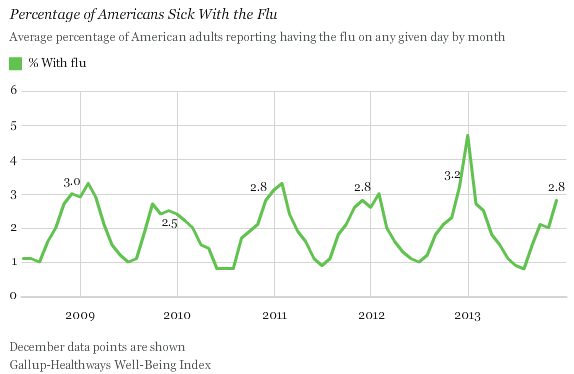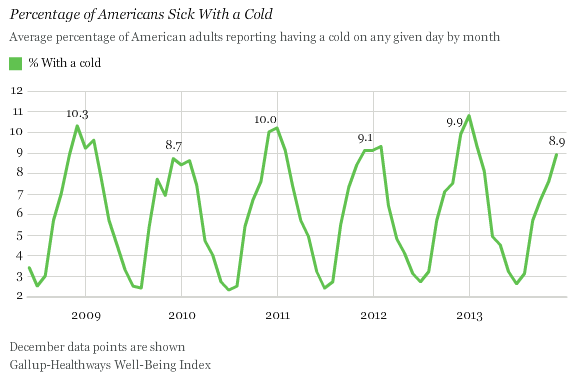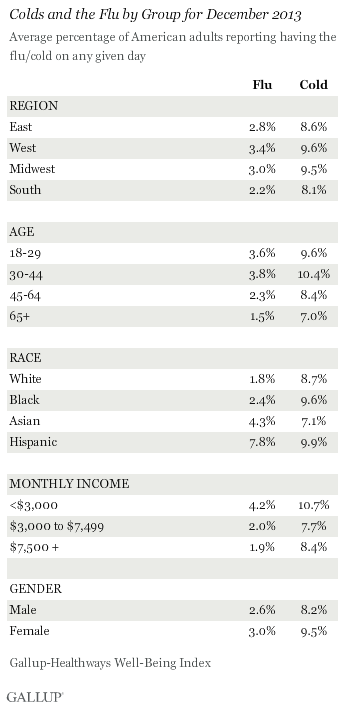WASHINGTON, D.C. -- The average percentage of U.S. adults who report being sick with the flu "yesterday" increased to 2.8% in Gallup's December polling, up from 2.0% in November. The prevalence of flu has ticked up every December since Gallup and Healthways began daily tracking in 2008. Flu reports from December 2013 were lower than in December 2012, but similar to the prior four Decembers.

The latest December uptick is consistent with the Centers for Disease Control and Prevention flu surveillance data, which also suggests the flu is gaining traction throughout the country. The number of states reporting widespread flu activity -- a designation used when at least half of the regions in a state have confirmed evidence of the flu -- jumped from 10 to 25 between the weeks ending Dec. 21 and Dec. 28 in the CDC's FluView weekly reports. The CDC also reported that 4.3% of doctor visits in the last week of December were associated with flu-like illness, up from 3.0% the week before.
The Gallup-Healthways Well-Being Index asks 500 Americans each day whether they had a cold or the flu "yesterday." It is possible that this measure of daily cold and flu underestimates the true rate, because those who were sick the day before may be less likely to respond to a phone survey than those who were not sick. Additionally, it may be difficult for people to accurately self-diagnose the illness as the flu versus a cold. Still, year-over-year comparisons provide useful information about the relative prevalence of flu and colds in the U.S. population.
Flu and colds in the U.S. typically follow a seasonal pattern, with Americans' self-reports of the illnesses rising in the fall months, peaking in the winter months, and declining in the spring and summer months. The only major exception to this pattern was when flu reports peaked in October 2009, amid the outbreak of the H1N1 flu virus.
Percentage of Adults With Colds Lower Than Usual in December
U.S. adults were about three times as likely to have a cold as to have the flu in December, as is usually the case. The percentage of adults who reported having a cold averaged 8.9%, the lowest for any December since 2009, when 8.7% reported being sick with a cold.

Hispanics, Low-Income, and Young to Middle-Aged Adults Most at Risk for Flu
Flus and colds disproportionally affected specific demographic and regional segments of the U.S. population in December.
Those living in the West and Midwest were more likely to report having the flu or a cold than those living in the East or South. The CDC data, however, indicates that the flu spread throughout much of the South during the last week of December. This, coupled with unusually low temperatures in the South, suggest that the region may face increasing flu and cold cases in January.
Overall, young and middle-aged adults were the most likely age groups to report having the flu or a cold. While this is consistent with what Gallup and Healthways have typically found, it also may be related to the particular strain of flu circulating. The CDC issued a health alert in December, warning that this season's strain may disproportionately affect young and middle-aged adults.
Additionally, Hispanics and those earning less than $3,000 per month are among those who are most likely to have the flu or a cold. This may be because these groups are more likely to use public transportation, are less likely to have health insurance that covers the cost of flu shots, and are less likely to have access to medical doctors who may recommend a flu shot.

Implications
The average flu level in December was generally on par with levels in previous Decembers, while the average cold rate was slightly lower than in the same month in prior years.
Hispanics, low-income earners, and 18- to 44-year-old adults are the most likely to report being sick with the flu, so public health officials should consider targeting their messaging for these groups. These groups should be educated on ways to protect themselves against the flu and colds, as well as how to prevent spreading these illnesses, including frequent hand washing, staying home when sick, disinfecting shared surfaces, and getting a flu shot.
Survey Methods
Results are based on telephone interviews conducted as part of the Gallup-Healthways Well-Being Index survey Dec. 1- 31, 2013, with a random sample of 13,186 adults, aged 18 and older, living in all 50 U.S. states and the District of Columbia.
For results based on the total sample of national adults, the margin of sampling error is ±1 percentage points at the 95% confidence level.
Interviews are conducted with respondents on landline telephones and cellular phones, with interviews conducted in Spanish for respondents who are primarily Spanish-speaking. Each sample of national adults includes a minimum quota of 50% cellphone respondents and 50% landline respondents, with additional minimum quotas by time zone within region. Landline and cellular telephone numbers are selected using random-digit-dial methods. Landline respondents are chosen at random within each household on the basis of which member had the most recent birthday.
Samples are weighted to correct for unequal selection probability, nonresponse, and double coverage of landline and cell users in the two sampling frames. They are also weighted to match the national demographics of gender, age, race, Hispanic ethnicity, education, region, population density, and phone status (cellphone only/landline only/both, cellphone mostly, and having an unlisted landline number). Demographic weighting targets are based on the March 2012 Current Population Survey figures for the aged 18 and older U.S. population. Phone status targets are based on the July-December 2011 National Health Interview Survey. Population density targets are based on the 2010 census. All reported margins of sampling error include the computed design effects for weighting.
In addition to sampling error, question wording and practical difficulties in conducting surveys can introduce error or bias into the findings of public opinion polls.
For more details on Gallup's polling methodology, visit www.gallup.com.
